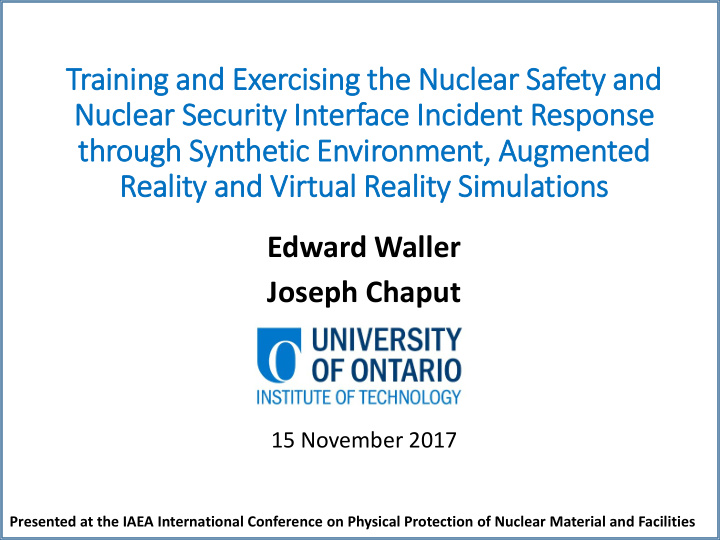



Trainin ing and Exercis ising th the Nucle lear Safety and Nucle lear Securit ity In Interface In Incid ident Response th through Synthetic Envir ironment, Augmented Reali lity and Vir irtual l Reali lity Sim imula latio ions Edward Waller Joseph Chaput 15 November 2017 Presented at the IAEA International Conference on Physical Protection of Nuclear Material and Facilities
Why we need to train 2
Interface of Safety and Security • Some areas of intersection: • Communications ( “ Need to know vs. Need to Share ” ) • Security by Design • Nuclear Material Control and Accountancy • Security Equipment Maintenance • Security Contingency Response in the Presence of High Activity Radiological Material • Modelling and Simulation Training 3
Military / police training Training College / university training for Nuclear Certification Security Facility specific training Exercising 4
Purposes of Exercises Progressive approach to training • Exercises are a way of • testing, • training, • evaluating, and • demonstrating capabilities in contingency response 5
Type Purposes Simulation Takes place without field execution varies in scope and number of personnel involved training Table top interagency coordination exercise/battle performance testing board testing and evaluating command and control structures training decision making Exercises Computer based validate vulnerability assessment exercise testing new concepts, procedures, physical protection measures and Exercise Takes place with field execution limited number of personnel training Associated Drills performance testing limited scope Purposes may include force-on-force engagement training Partial exercise performance testing testing and evaluating command and control structures training o training of all on-site and off-site agencies o training under real time and environmental conditions or simulated Full-scale coordination with all on-site and off-site agencies exercise based on force-on-force engagement evaluation of capabilities and proficiencies testing and evaluating command and control structures 6
Disadvantages of Traditional Approach to Exercises • Complex exercises are expensive • Require use of facilities/people/radiological material • Can take years to plan and arrange • Only a small set of players directly benefit with the experience • Safety or security priorities may dominate the planning and cause an interface exercise to be too focused in one direction 7
Future of Modelling and Simulation for the Safety-Security Interface • Synthetic environment : a computer simulation that represents activities at a high level of realism • Augmented reality : technologies that can project, superimpose or otherwise bring into focus computer- generated information (text, images, video, etc.) onto a view of the real world • Virtual reality : technologies that use computer- generated images, sounds and other sensations to replicate a ‘ realistic ’ environment that simulates a user ’ s presence in this environment • Immersive technology : any technology that provides a multi-modal sensory experience to engage and immerse users in a meaningful interactive scenario 8
Virtual Reality 3 rd person view VR view 9
Virtual Reality in the Nuclear Industry • Virtual reality (VR) technology has been in development for decades • Current technology has hit a point where a VR setup is affordable as a consumer product • VR is an effective way to engage your audience • Immersive experiences enhance the user experience • Recent experiment used VR technology for running emergency transport exercises with industry experts from around the world • Very positive feedback
Real Time Assessment of Player Actions Possible (& Desirable) 11
Video 1
Video 2
Video 3
Video 4
Video 5
Advantages of Leveraging Virtual Reality Technology • Reproducibility : The same scenario can be replayed by nuclear safety and security personnel • Shared experience with different perspectives afterwards • Post-exercise discussions enhance awareness of the others ’ priorities • Observing and discussing while the exercise is taking place is a teaching tool • ALARA : No radiological sources needed! • Scalability : Large scale exercises or quick drills are both possible • Interoperability : Enhancing awareness of concerns from both sides achieves mutual understanding 17 between both sides
Final words… • Simulation cannot replace hands-on training and exercising, but it can enhance both • Modelling and simulation for nuclear security is a cost- effective way to explore security system effectiveness and the ramification of system upgrades or changes • Provision for both perturbation analysis AND reproducibility • Virtual environments can immerse participants in realistic adversary scenarios with • Low cost • Low physical footprint • Low probability of injury 18
Thank you 19
Recommend
More recommend